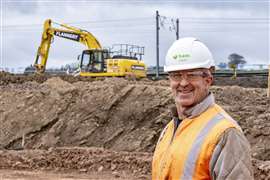How a major contractor is experimenting with injecting hydrogen into diesel engines
03 November 2023
 Image courtesy of BAM
Image courtesy of BAM
The UK arm of Netherlands-based contracting giant BAM is leading a new project that will see it run excavators specially adapted to inject hydrogen into the diesel engines of conventional excavators.
The trial, which has received nearly £5 million (€5.8 million) in funding from the UK government’s Department for Energy Security & Net Zero, is aimed at reducing carbon emissions from existing diesel off-highway machines prior to alternative forms of energy generation going mainstream.
The project involves mounting a hydrogen tank to the excavators. BAM and its partners have been working with Liverpool-based hydrogen solutions company ULEMCo to find a way to inject hydrogen through the air intake of a diesel excavator engine to displace a proportion of the diesel it normally runs on.
But speaking to International Construction, BAM’s innovation technical lead for the UK and Ireland Colin Evison explained, “We aren’t just looking at the construction plant itself but also how you generate the diesel, where it is generated, how you transport it, how you deliver to the site and how you distribute it around the site. When you think about how we use diesel, it comes from a supply, goes into a bowser and refuels machines. So how would we do the same for a fuel such as hydrogen?”
The project, called Element One, started in July but is still in the very early stages. It will run until March 2025.
Explaining the motivation behind leading the trial, Evison explained, “We recently made the decision to mandate the use of HVO within BAM, as opposed to diesel. We see that a stepping stone to what the future solution might be.
“We know electrification works on some pieces of equipment but it can be a challenge for larger pieces of mobile equipment. And we know that companies like JCB are developing hydrogen combustion engines, along with other manufacturers.
“But we have a huge amount of construction plant already in use within the industry. Some of it has just rolled off production lines a few months ago and now it’s working on site. It’s going to have a considerable working life before it becomes obsolete. So we have been thinking about how we convert the plant fleet that is already in use.”
How the trial will work
While BAM is leading the project, fellow contractor Skanska will also provide construction sites to demonstrate the solution.
The Element One trial involves four machines in total – two Cat excavators and two Kobelco excavators – that will be supplied by hire firms Flannery and Plantforce. Consortium partners ULEMCo and NanoSUN will help to develop equipment used to transport and refuel the machines with hydrogen.
Evison said he expected the machines to be ready to go to site by the third or fourth quarter of 2024.
Asked what he expected the biggest challenges or adjustments to be for contractors working with the machines, Evison said, “It’s a different behaviour pattern because we are looking at daily refuels at this stage. That is because of the limitations of how much volume you can store using conventional available technology.
“There isn’t an off-road vehicle that we can use to take the hydrogen to the machine at this stage, so that is one of the things we are developing. Actually, just having hydrogen on a construction site is novel. We understand the risks and hazards associated with different fuels but hydrogen is something that as an industry we need to get to grips with.”
“We think we can have a suitable mounting place for the tanks on the excavators. But until we put it to work on site, it is all a working theory. I am sure we will uncover more challenges once we are in a site environment.”
Carbon savings
At this stage, it is too early to say precisely what the amount of carbon savings the technology could make. Only once the machines are working on site will that become clearer. But Evison estimates that it could be between a 30% and 60% carbon saving.
“What we are helping to do with this trial is to increase the maturity [of the technology],” Evison said.
“There’s a lot of young companies that have started up in the last few years working in this area but conversely there’s a massive need for liquid fuels in the construction industry. So there’s a big difference between capability versus demand,” he added.
Evison said he hoped the trial could help upscale the capacity of the infrastructure by proving the concept.
He concluded, “As well as the technical ambition, the Element One project aims to address barriers to hydrogen production, supply and use including skills and training needs, health and safety and regulatory issues. The demonstration will support market assessment and business cases for investment and will measure and assess impacts on site productivity and emissions compared to conventional diesel plant.
“Ultimately, our aim is to shift hydrogen-powered plant use from being an experimental concept to creating practical solutions that allow implementation on busy construction sites. Importantly, all of our learnings will also be disseminated to wider industry.”
STAY CONNECTED



Receive the information you need when you need it through our world-leading magazines, newsletters and daily briefings.
CONNECT WITH THE TEAM








